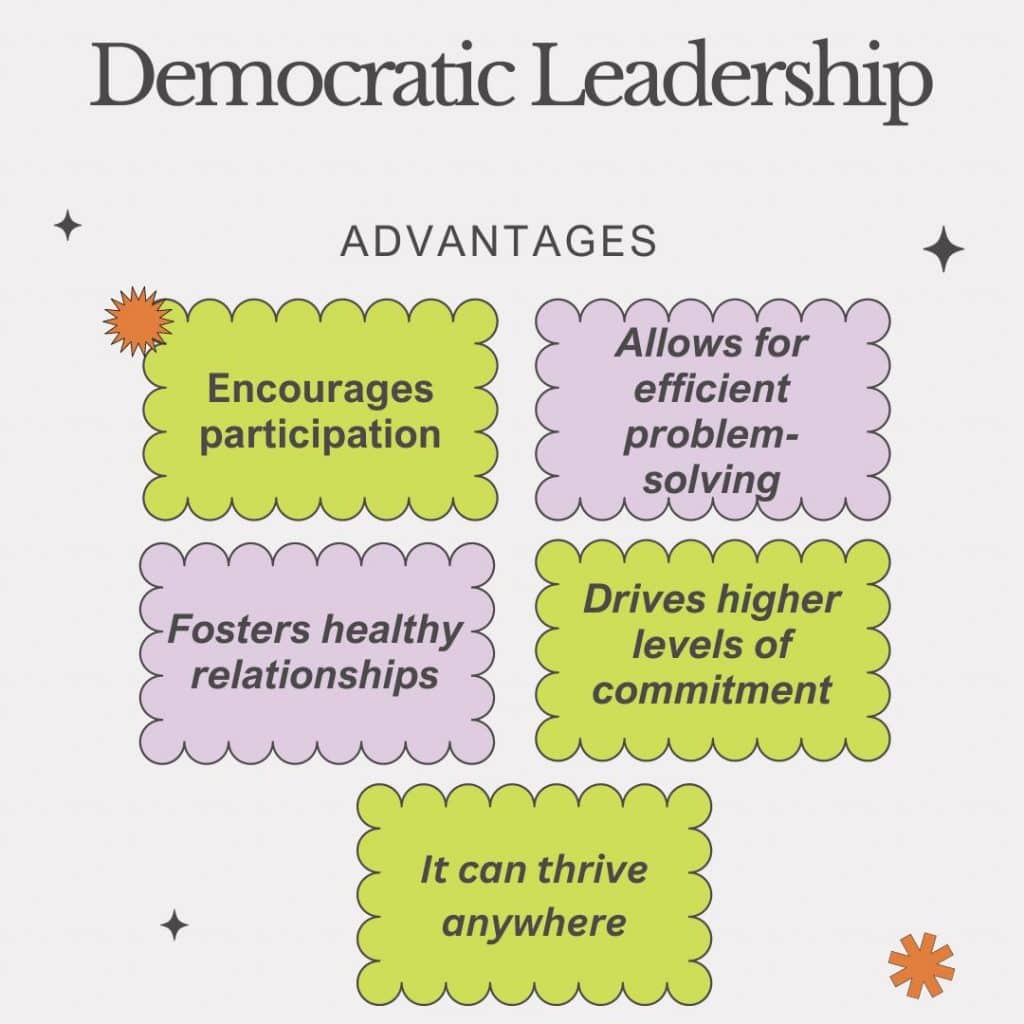Democratic leadership is a form of leadership style that empowers group members in the decision-making process. You may want to consider this style if you work in an industry that benefits from open discussion and shared opinions. Here, we’ll discuss how democratic leadership works, including the advantages and challenges involved in adopting this leadership style.
What is a Democratic Leadership Style?
The word democracy means “run by the people.” Democratic leadership, therefore, is a leadership style that involves allowing multiple people to participate in the organization’s decision-making process. Democratic leadership is also commonly referred to as participative leadership. The main aim of this type of leadership is to boost employee engagement within their role and in the company – it’s common knowledge that people actively involved in the organization’s affairs are more likely to stay invested.
Characteristics of The Democratic Leadership Style
Democratic leadership:
- Encourages creativity and collaboration in the workplace
- Maintains flexibility
- Prioritizes Transparency and communication
- Encourages teamwork
- Appreciates Feedback
With the different kinds of leadership styles available, what makes democratic leadership different from the others? Well, the answer is not far-fetched. Democratic leadership works best for those who want their team to get involved with problem-solving and decision-making in the organization. Ultimately, democratic leaders strive to:
#1. Encourage creativity and collaboration
If you enter any organization that thrives on democratic leadership, you’ll discover a high level of creativity and innovation. This is because democratic leaders tend to create opportunities to collaborate, facilitate brainstorms, and give room for input from team members before deciding on a matter. This invariably helps to bring out the best in the team members.
#2. Maintain flexibility
Democratic leaders believe that every team member is unique, and allow them to go about their duties how they see fit. They often delegate duties and decisions to their team, while observing from a distance.
#3. Prioritize Transparency and communication
Democratic leaders always prioritize open communication with their team. This helps create a strong sense of trust, strengthening the overall culture. Leaders with this style may tell their team about exciting new projects and ask for volunteers before delegating duties.
#4. Encourage teamwork

Democratic leaders value collaboration, and so they encourage teamwork by introducing team-building activities to help foster a healthy relationship between the members.
Read Also: FOCUS GROUP: Definition and Detailed Guide on How to Run a Focus Group Discussion
#5. Appreciate Feedback
Democratic leaders ask for feedback and appreciate the opinions of others. They may ask for feedback about something in an open-ended way, or test ideas with the group by explaining their solution to a problem and then asking what the group thinks.
#6. Builds a strong and clear vision for the future
To succeed, a democratic leader needs to clearly define and articulate a vision for the future that team members can align with. A solid organizational vision is a foundation for inviting contributions and facilitating greater teamwork.
Advantages of Democratic Leadership

Involving your team in the decision-making process will not always be a smooth ride, but it sure has its advantages:
#1. Democratic leadership encourages participation
You won’t know the potential qualities of your team members until you indulge them. Democratic leadership helps enhance the potential of team members by actively indulging them in crucial matters. When the opinion of a team member is constantly sought after, the person feels recognized and does their best to provide value to the organization.
#2. Democratic leadership makes room for more efficient problem-solving
When more people are involved in solving a problem, the number of potential solutions increases. Holding up a potential solution to commendations – and criticism – from team members is a good way to identify weaknesses and drawbacks before implementation, rather than cleaning up the mess afterward.
#3. Democratic leadership fosters healthy relationships
Democratic leadership helps foster healthy relationships by creating a workplace that encourages open communication and transparency. In this kind of environment, employees can interact with each other and share their ideas without feeling condescended to.
Read Also: THE IDEAL WORK ENVIRONMENT: Things That Make up an Ideal Work Environment
#4. Drives higher levels of commitment
When a team member brings up an idea and it is appreciated and implemented, the person will become more committed to meeting his goals, knowing that he will always be heard. When used correctly, democratic leadership can foster positive and healthy company cultures.
#5. It can thrive anywhere
Unlike some other leadership styles, democratic leadership can thrive in many workplaces. In situations with strong procedural elements, there is not as much scope to incorporate collective decision-making, but any workplace with teams can benefit.
Democratic Leadership in Practice

Early in my career, I joined a company undergoing a cultural shift towards democratic leadership. As HR Manager, I played a major role in facilitating this transition. During one of our team meetings, a junior employee (an intern actually) proposed a brilliant idea to streamline our recruitment process. Rather than dismissing it, our CEO welcomed the suggestion and encouraged the team to explore the project. This ignited a significant level of enthusiasm and motivation within our team, and as we collectively brainstormed solutions and implemented the idea, there was a considerable increase in morale and productivity.
Many other companies have achieved a level of success by incorporating democratic leadership, and I’ll mention some of them below:
#1. Google
Google’s founders, Larry Page and Sergey Brin, demonstrated a democratic leadership style by encouraging employees to participate in decision-making and fostering a culture of open communication. This approach has driven a level of innovation and collaboration, and we can see how successful Google has become over the years.
#2. Netflix
Netflix’s story is an interesting one, as we see the CEO, Reed Hastings, transition from autocratic leadership to democratic leadership. It didn’t just affect his personal life; it also helped his business, as Netflix is now one of the biggest streaming services on the internet.
#3. Southwest Airlines
With its focus on employee engagement and empowerment, Southwest Airlines attributes much of its success to democratic leadership practices that prioritize employee well-being and satisfaction.
#4. Valve Corporation
Known for its flat organizational structure, Valve operates without traditional management hierarchies, allowing employees to choose projects and allocate resources autonomously.
Challenges of Democratic Leadership
Before you decide to adopt this leadership style, you should be aware of the following challenges:
#1. Slow decision-making
It’s quite challenging to make decisions if you need everyone’s input before implementing anything. The time needed to organize meetings and discussions can be detrimental to your business when it necessitates quick decisions or involves deadlines.
#2. Possible decline in performance
You may encounter some employees who are less able to perform under democratic leadership because they don’t like making decisions. They might also have the impression that they work harder than the leader. One of the ways to combat this is to vet your employees properly during the hiring process.
Read Also: EMPLOYEE ONBOARDING: What You Should Know About The Entire Onboarding Process
#3. Leaders can feel overwhelmed
Leaders can find it this style of leadership takes more time and effort when a team consensus is needed. This extra work may contribute to missed deadlines and potential leader burnout.
Developing Democratic Leadership Skills
- Define your vision and values
- Involve your team in decision-making
- Delegate duties
- Encourage collaboration and innovation
- Recognize and reward your team
To better implement democratic leadership in your organization, here are some things you should do:
#1. Define your vision and values
As a democratic leader, you need to have a clear and compelling vision for your organization or project and communicate it to your team. Your vision should also align with your core values, and they should reflect in your words and actions. These will guide your decisions, goals, and strategies, and motivate your team to work towards a common purpose.
#2. Involve your team in decision-making
If your team isn’t involved in the decision-making process, then it isn’t democratic leadership. Involving them includes seeking their input, opinions, and ideas, and considering them seriously. It also means giving them a voice and a vote in important matters and explaining the reasons behind your choices. By involving your team in decision-making, you show them that you value their perspectives, respect their autonomy, and trust their judgment.
#3. Delegate duties
As a democratic leader, you should learn to delegate tasks and responsibilities to your team members according to their skills, interests, and potential. This frees up your time and energy for more strategic work and empowers your team to take ownership of their work, learn new things, and develop their capabilities. Delegation also requires you to provide clear expectations, guidelines, and feedback, and to offer support and guidance when needed.
#4. Encourage collaboration and innovation
Create opportunities for your team members to brainstorm, experiment, and try new approaches. As a democratic leader, you should facilitate teamwork, promote diversity, and celebrate creativity. You should also welcome constructive criticism, feedback, and suggestions, and be open to change and improvement.
#5. Recognize and reward your team
Strive to recognize and reward your team for their efforts, achievements, and contributions. This means acknowledging their work, expressing appreciation, and giving praise. It also means providing incentives, rewards, and recognition that are meaningful, fair, and consistent. By recognizing and rewarding your team, you boost their morale, confidence, and loyalty. You also reinforce the positive behaviors and outcomes that you want to see more of.
Read Also: AWARDS FOR EMPLOYEES: Best Fun Tips, Service & Recognition Ideas
What Is The Opposite of Democratic Leadership?
The opposite of democratic leadership is autocratic leadership, where decision-making is centralized, and leaders exert full control without input from others.
In Conclusion,
Democratic leadership involves encouraging participation from others in the organisation as part of the decision-making process. Under this form of leadership, everyone is encouraged to participate, leading to increased feelings of involvement, recognition, and satisfaction.
- DATA REPORT: Definition, Tools and Tips
- Building a Data-Driven Culture: Education and Training within Organizations
- HOW TO CALCULATE OPPORTUNITY COST: EASY Steps With Formula
- WHAT ARE LEADERSHIP SKILLS? The 7 Core Skills Of A Leader






